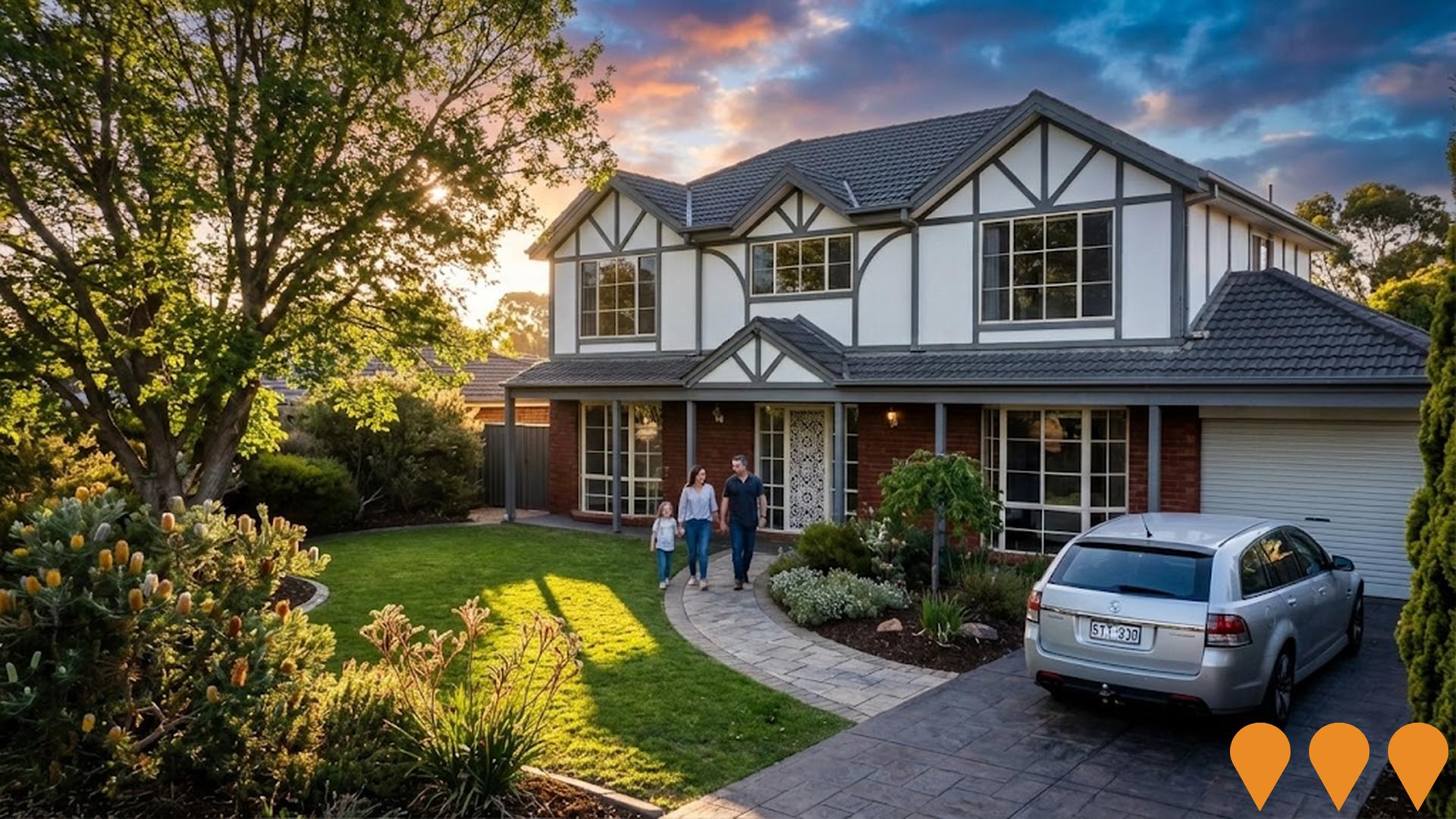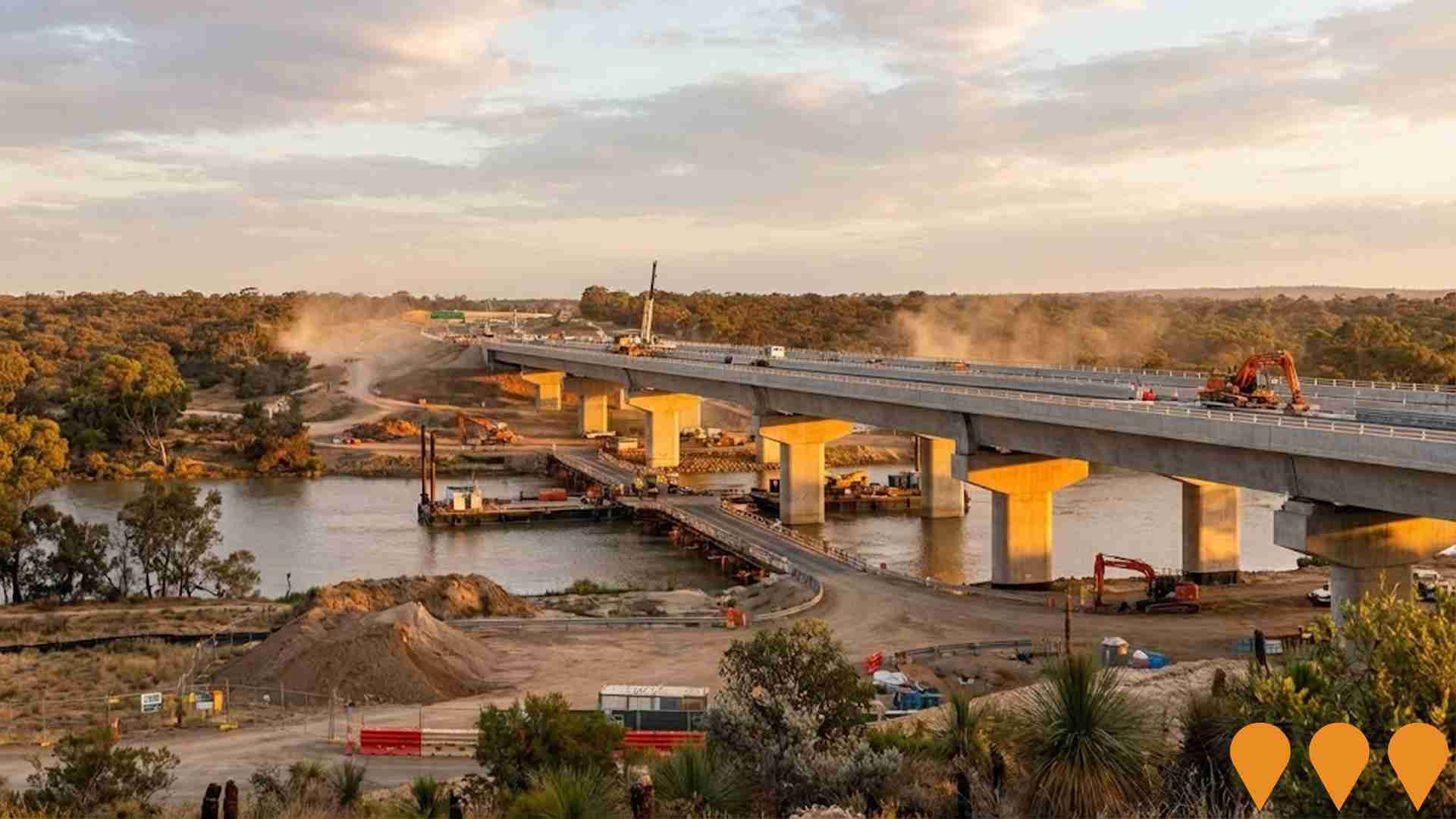Chart Color Schemes
est. as @ -- *
ABS ERP | -- people | --
2021 Census | -- people
Sales Activity
Curious about local property values? Filter the chart to assess the volume and appreciation (including resales) trends and regional comparisons, or scroll to the map below view this information at an individual property level.
Find a Recent Sale
Sales Detail
Population
An assessment of population growth drivers in Clarendon reveals an overall ranking slightly below national averages considering recent, and medium term trends
Clarendon's population is around 2,854 as of Aug 2025. This reflects an increase of 125 people since the 2021 Census, which reported a population of 2,729. The change is inferred from ABS estimated resident population of 2,859 in June 2024 and three additional validated addresses since the Census date. This equates to a density ratio of 23 persons per square kilometer. Clarendon's growth rate of 4.6% since the census is within 0.2 percentage points of its SA3 area (4.8%). Population growth was primarily driven by interstate migration, contributing approximately 57.5% of overall gains.
AreaSearch adopts ABS/Geoscience Australia projections for each SA2 area, released in 2024 with a base year of 2022. For areas not covered and years post-2032, SA State Government's Regional/LGA projections by age category are adopted, based on 2021 data and adjusted using weighted aggregation from LGA to SA2 levels. Future trends indicate a population increase just below the median of statistical areas analysed, with an expected expansion of 381 persons to 2041, recording a gain of 13.5% over 17 years.
Frequently Asked Questions - Population
Development
Residential development activity is lower than average in Clarendon according to AreaSearch's national comparison of local real estate markets
Clarendon has received approximately 13 dwelling approvals per year over the past five financial years, totalling 67 homes. No approvals have been recorded so far in FY26. On average, 1.8 new residents arrived annually for each new home between FY21 and FY25, indicating balanced supply and demand. However, this has increased to 7.2 people per dwelling over the past two financial years, suggesting growing popularity and potential undersupply. New properties are constructed at an average cost of $632,000, reflecting a focus on premium segment development.
This year, Clarendon has seen $528,000 in commercial development approvals, demonstrating its residential nature. Compared to Greater Adelaide, Clarendon maintains similar construction rates per person, preserving market equilibrium. All new construction consists of standalone homes, maintaining the area's low density and attracting space-seeking buyers.
Currently, there are estimated to be 591 people in the area for each dwelling approval. Population forecasts indicate Clarendon will gain 386 residents by 2041. Existing development levels appear aligned with future requirements, maintaining stable market conditions without significant price pressures.
Frequently Asked Questions - Development
Infrastructure
Clarendon has emerging levels of nearby infrastructure activity, ranking in the 32ndth percentile nationally
Changes to local infrastructure significantly impact an area's performance. AreaSearch has identified ten projects expected to influence the region. Notable initiatives include Thalassa Park Master Plan, Urban Creek Resilience and Recovery Project - Sauerbier and Homestead Creeks, Aberfoyle Community Centre Expansion, and Aberfoyle Park High School Redevelopment. The following list details those most likely to be relevant.
Professional plan users can use the search below to filter and access additional projects.
INFRASTRUCTURE SEARCH
 Denotes AI-based impression for illustrative purposes only, not to be taken as definitive under any circumstances. Please follow links and conduct other investigations from the project's source for actual imagery. Developers and project owners wishing us to use original imagery please Contact Us and we will do so.
Denotes AI-based impression for illustrative purposes only, not to be taken as definitive under any circumstances. Please follow links and conduct other investigations from the project's source for actual imagery. Developers and project owners wishing us to use original imagery please Contact Us and we will do so.
Frequently Asked Questions - Infrastructure
Onkaparinga Heights
A ~235 hectare masterplanned community in Adelaide's southern suburbs, delivering up to 2,000 new homes across a 67.6ha Renewal SA site (minimum 20% affordable housing) and adjacent private land. Infrastructure deeds signed, RFP closed October 2025. Features sustainable design, diverse housing options, excellent connectivity via Southern Expressway and future North-South Corridor, proximity to McLaren Vale wine region, Port Noarlunga beach, Onkaparinga River National Park and beaches.
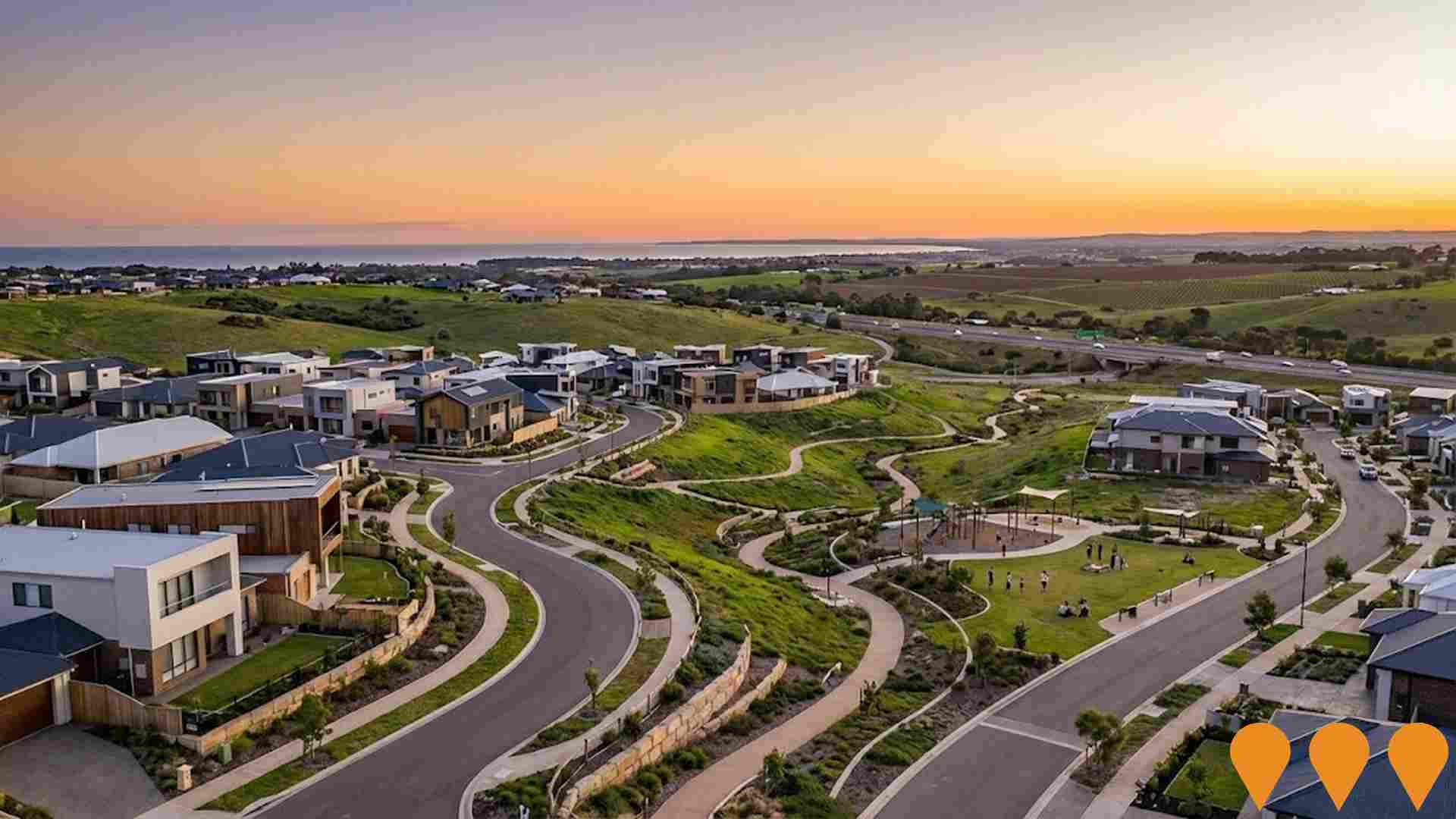
South Eastern Freeway Upgrade
Major $350 million upgrade to improve incident management, safety, reliability, and capacity along the South Eastern Freeway, a key corridor between Adelaide and the Adelaide Hills. This project includes the Heysen Tunnels Refit and Safety Upgrade and the delivery of a Managed Motorway System between Crafers and Glen Osmond. The Managed Motorway System will include Intelligent Transport Systems for lane-use management, variable speed limit signs, and median barrier gates to enable contra-flow during incidents. The Heysen Tunnels refit, completed in late 2024, included upgrading lighting, ventilation, and fire suppression systems.
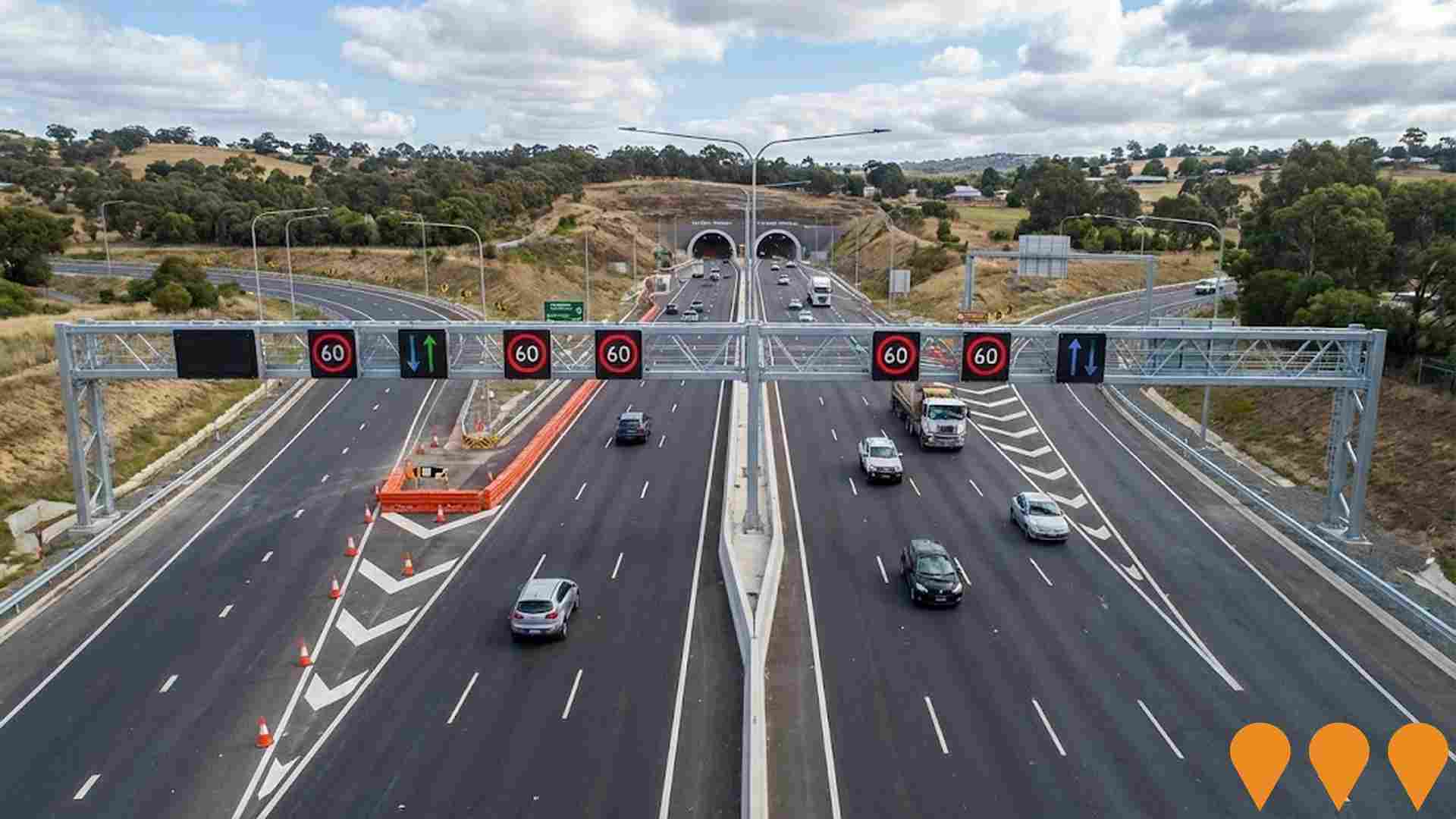
Adelaide Public Transport Capacity and Access
State-led program work to increase public transport capacity and access to, through and within central Adelaide. Current work is focused on the City Access Strategy (20-year movement plan for the CBD and North Adelaide) and the State Transport Strategy program, which together will shape options such as bus priority, interchange upgrades, tram and rail enhancements, and better first/last mile access.
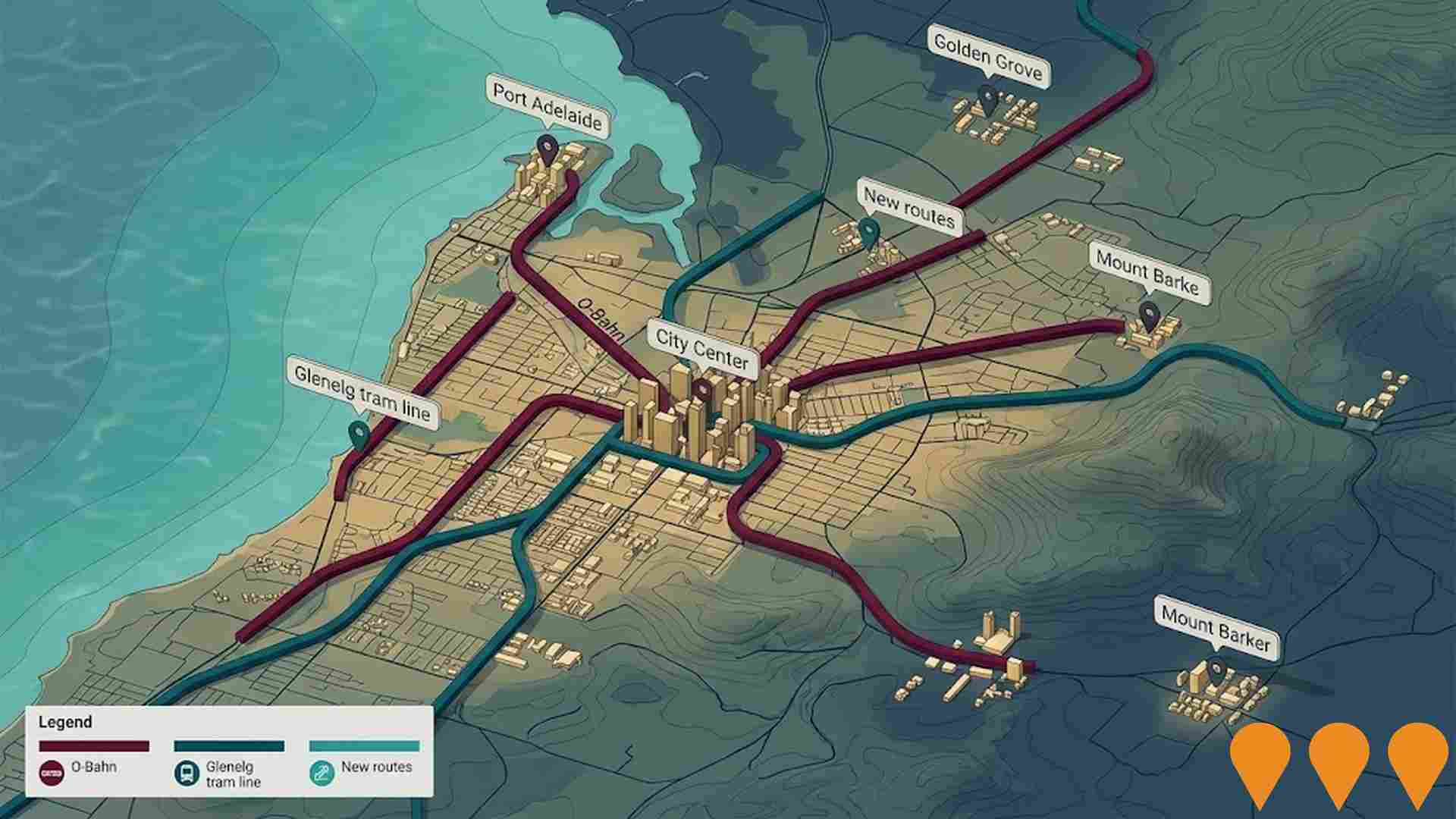
Urban Creek Resilience and Recovery Project - Sauerbier and Homestead Creeks
A $1.83 million watercourse rehabilitation project funded by the Australian Government's Natural Heritage Trust under the Urban Rivers and Catchments Program. The project aims to improve the health of Sauerbier Creek and Homestead Creek within the upper Field River catchment in Aberfoyle Park. Key activities include upgrading stormwater flows and creek banks with improved drainage structures, installing natural erosion control solutions using logs, rocks and permeable fabric, adding wildlife-friendly litter traps, creating safe spaces and habitat refuges for threatened species including Southern Brown Bandicoots and Cunningham's Skinks, controlling weeds and planting local native species, and enhancing community connections with nature through workshops, signage and conservation activities. The project will restore creek areas, banks and aquatic habitats while improving water quality, waterway connectivity and biodiversity.

High Productivity Vehicle Network (HPVN)
$525 million federal funding for High Productivity Vehicle Network. Duplication of Swanport Bridge and Murray Bridge Township Bypass in Monarto. Enables higher productivity vehicles to bypass Adelaide, reducing trips, carbon emissions, improving freight efficiency and safety. Affects southern corridor transport.

Aberfoyle Community Centre Expansion
A $1.61 million expansion of the Aberfoyle Community Centre completed in April 2025. The project added a new flexible open-plan building at the rear of the existing facility, featuring a versatile space for dance and messy activities, a youth pod with lowered ceiling and retractable curtains, and an art studio equipped with pottery kilns, wheels, moveable tables and lockers. The expansion includes acoustic features such as acoustic glass for music activities, vinyl flooring and wall mirrors for dance and fitness, high-level windows for natural light, verandas creating indoor-outdoor connections, and a central outdoor area for informal gatherings. The new spaces enable simultaneous programming with existing multifunctional rooms, supporting arts, crafts, dance, exhibitions, youth programs, family activities, and social gatherings. Funded through a Community Infrastructure Grant from the Department of Infrastructure and Transport with $1.5 million from the State Government of South Australia (secured by Erin Thompson MP, Member for Davenport) and $110,000 from the City of Onkaparinga. Construction began in early 2024 and was completed in February 2025 after 12 months, with the existing centre remaining operational throughout to minimize disruption to users.

Aberfoyle Park High School Redevelopment
A $14 million facility upgrade completed in May 2022 including redevelopment of the performing arts centre with a 250-seat theatre, refurbishing existing buildings to create contemporary learning spaces and collaborative areas, creation of a new entrance and administration building, and enhanced indoor-outdoor learning environments. The project was delivered in three stages to minimize disruption to the school's 1,150 students and features contemporary architecture with natural materials and an earthen green palette inspired by the Australian bush.

Thalassa Park Master Plan
Development of a comprehensive master plan to guide future improvements and development of Thalassa Park. The plan will address playgrounds, walking and cycling trails, event spaces, gardens, accessibility features, and the Storybook Walk sculpture park. The Council design team is working with the Thalassa Park and Gardens Trust to ensure the revised master plan aligns with timeframe and budget planning. Community and stakeholder feedback will be sought once the draft master plan is available.

Employment
AreaSearch analysis of employment trends sees Clarendon performing better than 90% of local markets assessed across Australia
Clarendon has an educated workforce with significant representation in essential services sectors. Its unemployment rate is 1.5% as of June 2025, lower than Greater Adelaide's 4.0%.
Employment growth over the past year was estimated at 2.7%. There are 1,724 residents employed, with an unemployment rate of 2.5% below Greater Adelaide's and workforce participation at 66.0%, compared to Greater Adelaide's 61.7%. Major employment sectors include health care & social assistance, construction, and education & training. Agriculture, forestry & fishing shows notable concentration, with levels at 4.2 times the regional average.
However, accommodation & food services are under-represented, at 4.5% compared to Greater Adelaide's 6.8%. The area may have limited local employment opportunities, indicated by Census working population vs resident population count. In the year ending June 2025, employment increased by 2.7%, labour force by 2.7%, with unemployment essentially unchanged. This contrasts with Greater Adelaide where employment and labour force grew by 2.1% each, and unemployment rose marginally. Jobs and Skills Australia's national employment forecasts from May 2025 project a 6.6% increase over five years and 13.7% over ten years. Applying these projections to Clarendon's employment mix suggests local growth of approximately 6.4%% over five years and 13.5% over ten years, though this is a simple weighting extrapolation for illustrative purposes only.
Frequently Asked Questions - Employment
Income
The economic profile demonstrates above-average performance, with income metrics exceeding national benchmarks based on AreaSearch comparative assessment
According to AreaSearch's aggregation of ATO data released for financial year 2022, Clarendon had a median income among taxpayers of $51,515. The average income was $68,251. Both figures are higher than the national averages of $52,592 and $64,886 respectively in Greater Adelaide. Based on Wage Price Index growth since financial year 2022, estimated median and average incomes as of September 2025 would be approximately $58,124 and $77,008 respectively. According to the 2021 Census, household, family, and personal incomes in Clarendon cluster around the 61st percentile nationally. The largest income segment comprises 31.8% earning between $1,500 and $2,999 weekly, with a total of 907 residents. This pattern is similar to that seen in the region where 31.8% also fall within this range. A substantial proportion, 30.3%, earn above $3,000 weekly, indicating strong economic capacity throughout the locality. After housing costs, residents retain 88.9% of their income, reflecting strong purchasing power. The area's SEIFA income ranking places it in the 7th decile.
Frequently Asked Questions - Income
Housing
Clarendon is characterized by a predominantly suburban housing profile, with above-average rates of outright home ownership
Clarendon's dwelling structure, as per the latest Census, consisted of 99.5% houses and 0.5% other dwellings (semi-detached, apartments, 'other' dwellings), contrasting with Adelaide metro's 89.2% houses and 10.7% other dwellings. Home ownership in Clarendon stood at 49.1%, with mortgaged dwellings at 44.2% and rented ones at 6.7%. The median monthly mortgage repayment was $2,000, higher than Adelaide metro's average of $1,452, while the median weekly rent was $290, lower than Adelaide metro's $314. Nationally, Clarendon's mortgage repayments exceeded the Australian average of $1,863, but rents were substantially below the national figure of $375.
Frequently Asked Questions - Housing
Household Composition
Clarendon features high concentrations of family households, with a higher-than-average median household size
Family households constitute 83.0% of all households, including 38.6% couples with children, 37.4% couples without children, and 6.6% single parent families. Non-family households account for the remaining 17.0%, with lone person households at 15.0% and group households comprising 1.3%. The median household size is 2.7 people, which is larger than the Greater Adelaide average of 2.5.
Frequently Asked Questions - Households
Local Schools & Education
The educational profile of Clarendon exceeds national averages, with above-average qualification levels and academic performance metrics
Educational attainment in Clarendon is notably high, with 31.7% of residents aged 15+ holding university qualifications, compared to 18.9% in the SA3 area and 25.7% nationally (as of 2021). Bachelor degrees are most common at 21.1%, followed by postgraduate qualifications at 7.0% and graduate diplomas at 3.6%. Vocational credentials are also prevalent, with 37.1% of residents aged 15+ holding such qualifications - advanced diplomas at 11.8% and certificates at 25.3%. Educational participation is high, with 26.6% of residents currently enrolled in formal education, including 9.7% in primary, 8.3% in secondary, and 4.4% in tertiary education (as of 2021).
Clarendon Primary School and Kangarilla Primary School serve a total of 120 students, with typical Australian school conditions (ICSEA: 1041) and balanced educational opportunities. Both schools focus on primary education, with secondary options available in nearby areas due to limited local school capacity (4.2 places per 100 residents compared to the regional average of 13.6).
Frequently Asked Questions - Education
Schools Detail
Nearby Services & Amenities
Transport
No public transport data available for this catchment area.
Frequently Asked Questions - Transport
Transport Stops Detail
Health
Clarendon's residents are relatively healthy in comparison to broader Australia with a fairly standard level of common health conditions seen across both young and old age cohorts
Clarendon's health metrics closely match national benchmarks. Common health conditions are seen at a standard level across both young and old age cohorts.
Private health cover is high, with approximately 54% of the total population (~1,532 people). This compares to 48.6% across Greater Adelaide. The most common medical conditions are arthritis and asthma, impacting 8.6 and 8.3% of residents respectively. 67.0% of residents declare themselves completely clear of medical ailments, compared to 62.9% in Greater Adelaide. 24.1% of residents are aged 65 and over (687 people), higher than the 21.0% in Greater Adelaide. Health outcomes among seniors are strong, performing better than the general population in health metrics.
Frequently Asked Questions - Health
Cultural Diversity
Clarendon is considerably less culturally diverse than average when assessed alongside AreaSearch's national rankings for language and cultural background related metrics
Clarendon's population was found to be predominantly Australian-born, with 82.3% born in Australia and 91.5% being citizens. English was the language spoken at home by 97.0%. Christianity was the most prevalent religion, comprising 38.4% of Clarendon's population.
Notably, Judaism was not present among Clarendon residents, while it constituted 0.1% in Greater Adelaide. The top three ancestral groups were English (35.4%), Australian (31.9%), and Scottish (6.8%). Some ethnic groups showed notable variations: Polish was overrepresented at 1.2%, compared to 0.9% regionally, German at 6.0% versus 5.4%, and Dutch at 1.9% compared to 1.7%.
Frequently Asked Questions - Diversity
Age
Clarendon hosts an older demographic, ranking in the top quartile nationwide
Clarendon's median age of 48 years is significantly higher than Greater Adelaide's 39 and also higher than the national average of 38. Compared to Greater Adelaide, Clarendon has a higher proportion of residents aged 65-74 (15.1%) but fewer residents aged 25-34 (6.1%). This concentration of 65-74 year-olds is notably above the national average of 9.4%. Between the 2021 Census and the present, the proportion of residents aged 75 to 84 has increased from 6.2% to 8.3%, while the 15 to 24 age group has risen from 12.0% to 13.4%. Conversely, the 55 to 64 age group has decreased from 17.8% to 15.5%, and the 5 to 14 age group has dropped from 11.1% to 10.0%. By the year 2041, Clarendon's age composition is projected to undergo significant shifts. The 45 to 54 age group is expected to grow by 27%, increasing from 432 to 549 residents. However, the 65 to 74 age cohort is projected to decrease by 25 people.


